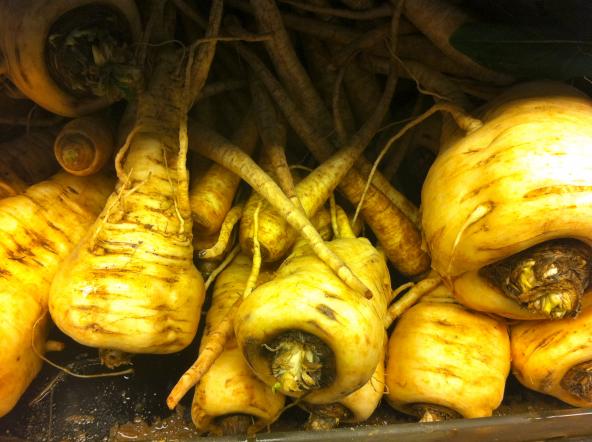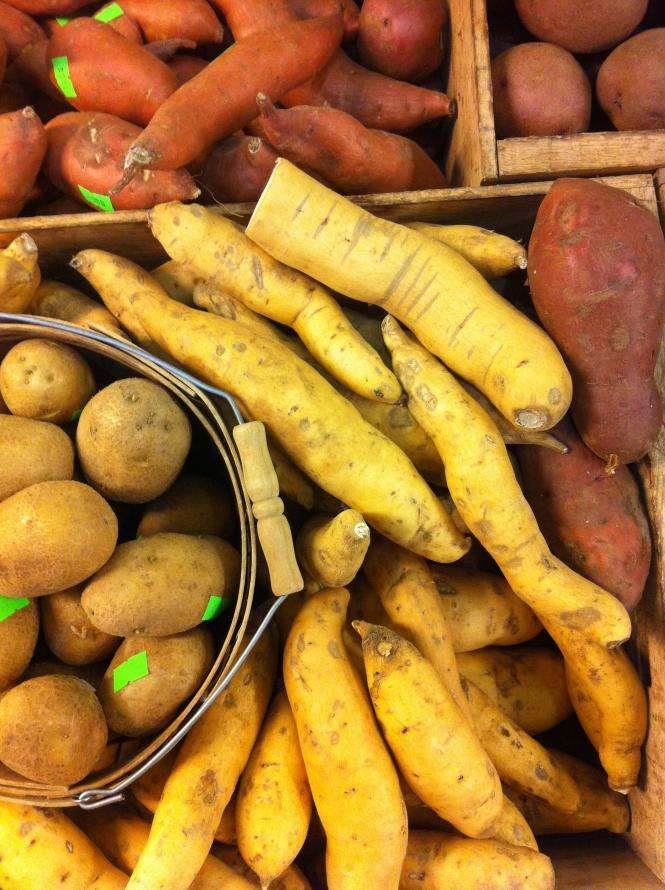February has arrived. I had dreaded the month’s arrival, certain that I would be sick and tired of eating "winter" foods by this point in the journey. My end of summer self told my future winter self that there was only so much joy to be had in eating my homemade canned goods, frozen vegetables, and the root vegetables and squash squirreled away in the garage. I had resolved that my taste buds would suffer and I had prepared myself for the worst. Turns out root vegetables proved me wrong.
After mass consumption of some delicious winter foods, I’m happy to report that my pessimism has fallen to the wayside. Who knew that root vegetables had so much more potential than their stated reputation as a soggy or bland group of veggies? From lip smacking sweet potato casserole to hearty rutabaga stew and zesty parsnip fries, there is a lot to be said in favor of edible roots. Beets, turnips, potatoes, carrots, radishes, celeriac, parsnips, and yams - the list is full of infinite culinary possibilities.
 Root vegetables, so named for their defining characteristic of growing underground, are an amazing food gift. They are rich in nutrients, large in size, inexpensive, and easy to store for long periods of time. In poor areas all over the world where water is scarce or unclean and refrigeration and money are hard to come by, root vegetables sustain many. Not long ago, our own mid-western ancestors survived long harsh winters by having parsnips, turnips, potatoes, carrots, and rutabagas stored away in the root cellar.
Root vegetables, so named for their defining characteristic of growing underground, are an amazing food gift. They are rich in nutrients, large in size, inexpensive, and easy to store for long periods of time. In poor areas all over the world where water is scarce or unclean and refrigeration and money are hard to come by, root vegetables sustain many. Not long ago, our own mid-western ancestors survived long harsh winters by having parsnips, turnips, potatoes, carrots, and rutabagas stored away in the root cellar.
One reason, of many, for which I try to eat local and seasonal is that I love the transformative way in which each new food presented on the shelves of my co-op or delivered by my CSA carries it’s own story, which in turn, enriches my life. Armed with more knowledge on the origins of food, I gain a sense of solidarity with my kin that was previously missing. Though my dad passed many years ago, I now have a new language of food in which to reach his brothers and sisters. My dad’s family grew up poor in money and resources, but rich in creativity and the ability to live off the provisions of the land. I now know a little more of what it’s like to be innovative when presented with a bag full of parsnips. I truly feel I have earned my family’s respect as a person in search of her "roots" and also as someone honoring the land. This is a far cry from the naive suburban kid I once was.
My most recent challenge was with a drawer full of daikon radishes, I had no idea what to make of the strange white, carrot-like veggies. Armed with my nearest iDevice, I searched “daikon radish”. I learned that “daikon”, a immensely popular vegetable in Japan, means “large root” in the Japanese language. I also learned that people from India and Pakistan call the vegetable “mooli.” The daikon or mooli is a very common vegetable that is easy to grow, affordable, and lauded for it’s ability to aid digestion. Upon learning this, my husband immediately flashed back to a childhood visit to his aunt’s house in a rural Pakistani village and recalled eating this dish; he then called his mom to share the story of how we wound up with mooli/daikon in our Minnesotan kitchen.
I then remembered an experience I had had last summer with my neighbor, who was born and raised in China. I was questioning her about what a certain vegetable was in her garden. She attempted to find the right English words to describe her crop; after a few bad attempts at trying to reach a consensus, we mutually agreed upon “white carrot,” (though I now know the daikon, rich and punchy in flavor, is nothing like a carrot.) Now, winter is here and I am eating all of these root vegetables and ended up showing a daikon to my neighbor and shared with her my cooking challenge. My neighbor, who was born and raised in China, exclaimed, “this is the white carrot I grow in my garden!”, and this prompted a good laugh.
Throughout this food experience I have gained both the health of body and the wealth of living. The daikon and all of it’s other root vegetable friends have brought it’s fortune to my table and my heart, making this winter all the more bearable. I hope you are encouraged to try your luck with roots and share your favorites with us!
Daikon Radish with Chicken

Adapted from a recipe found on food.com
Ingredients:
3 medium daikon radish
6 chicken legs with thigh
1 ½ teaspoons chili flakes
3 tablespoons oil
3 garlic clove, minced
3 teaspoons sesame oil
Cooking sauce:
6 cups chicken stock
9 tablespoons soy sauce
6 tablespoons sherry or rice wine
3 tablespoons sugar
salt and pepper to taste
Directions:
Peel and chop daikon (small circles or half moons depending on size od daikon).
Cut chicken into small to medium pieces.
Heat oil. Add daikon and chicken and sauté over high heat. Stir in crushed garlic and chili flakes/pepper.
Add all ingredients for the cooking sauce. Cook over medium heat, constantly skimming.
When the sauce has nearly evaporated, sprinkle sesame oil.
Remove from heat and serve over rice with julienned carrots and ginger to top.

Leigh Ann Ahmad was dragged kicking and screaming to the Cities by her husband; having been born and bred in Cleveland, Ohio, she just could not fathom how colder could be better. Now, five years and two kids later, she cannot imagine a better place to play and thrive. She’s a reformed carb-aholic, wannabe writer, social justice advocate, book-club geek, veggie grower and local foods connoisseur. Her last article for SGT was, Cast Iron!




